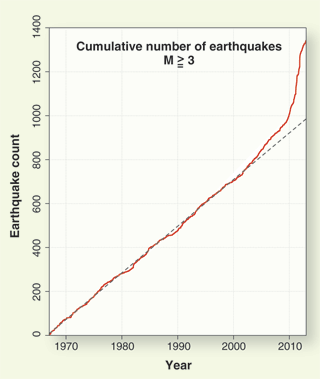 REVIEW: Injection-Induced Earthquakes
REVIEW: Injection-Induced Earthquakes
From William L. Ellsworth, Science Magazine, July 12, 2013
Source: Earthquake Science Center, U.S. Geological Survey, Menlo Park, CA
Background
Human-induced earthquakes have become an important topic of political and scientific discussion, owing to the concern that these events may be responsible for widespread damage and an overall increase in seismicity. It has long been known that impoundment of reservoirs, surface and underground mining, withdrawal of fluids and gas from the subsurface, and injection of fluids into underground formations are capable of inducing earthquakes. In particular, earthquakes caused by injection have become a focal point, as new drilling and well-completion technologies enable the extraction of oil and gas from previously unproductive formations.
Earthquakes with magnitude (M) ≥ 3 in the U.S. midcontinent, 1967–2012. After decades of a steady earthquake rate (average of 21 events/year), activity increased starting in 2001 and peaked at 188 earthquakes in 2011. Human-induced earthquakes are suspected to be partially responsible for the increase.
Advances
Microearthquakes (that is, those with magnitudes below 2) are routinely produced as part of the hydraulic fracturing (or “fracking”) process used to stimulate the production of oil, but the process as currently practiced appears to pose a low risk of inducing destructive earthquakes. More than 100,000 wells have been subjected to fracking in recent years, and the largest induced earthquake was magnitude 3.6, which is too small to pose a serious risk.
Yet, wastewater disposal by injection into deep wells poses a higher risk, because this practice can induce larger earthquakes. For example, several of the largest earthquakes in the U.S. midcontinent in 2011 and 2012 may have been triggered by nearby disposal wells. The largest of these was a magnitude 5.6 event in central Oklahoma that destroyed 14 homes and injured two people. The mechanism responsible for inducing these events appears to be the well-understood process of weakening a preexisting fault by elevating the fluid pressure. However, only a small fraction of the more than 30,000 wastewater disposal wells appears to be problematic—typically those that dispose of very large volumes of water and/or communicate pressure perturbations directly into basement faults.
Outlook
Injection-induced earthquakes, such as those that struck in 2011, clearly contribute to the seismic hazard. Quantifying their contribution presents difficult challenges that will require new research into the physics of induced earthquakes and the potential for inducing large-magnitude events. The petroleum industry needs clear requirements for operation, regulators must have a solid scientific basis for those requirements, and the public needs assurance that the regulations are sufficient and are being followed.
The current regulatory frameworks for wastewater disposal wells were designed to protect potable water sources from contamination and do not address seismic safety. One consequence is that both the quantity and timeliness of information on injection volumes and pressures reported to regulatory agencies are far from ideal for managing earthquake risk from injection activities. In addition, seismic monitoring capabilities in many of the areas in which wastewater injection activities have increased are not capable of detecting small earthquake activity that may presage larger seismic events.

{ 4 comments… read them below or add one }
Underground Injection Control Permit in Ritchie County
In light of the new study findings on triggered earthquakes….
From: The WV Host Farms Program
There is a request for a modification of an Underground Injection Control Permit in Ritchie County to allow third party haulers to deliver to this commercial disposal well. Application # UIC2D0859669. Do we want produced water from other states or counties coming to Ritchie County? Please take time to send public comments to oppose this permit application which can be received until June 21, 2013. Written comments may be sent to Office of Oil and Gas, 61 57th Street SE, Charleston, WV 25304, Attn: James Martin
Induced seismicity tied to the injection or withdrawal of fluids is well established and documented, as I wrote in my previous blog. And just like the induced earthquakes in the UK and Oklahoma, these earthquakes in Ohio likely could have been prevented by proper planning and site characterization.
As Frohlich notes, Texas isn’t alone in experiencing induced earthquakes linked to drilling injection wells. Ohio experienced a magnitude 4.0 earthquake earlier this year near the town of Youngstown. The New York Times reported that Ohio officials believe this quake, the eleventh such event in Youngstown in 2011, was the result of disposal wells.
For an industry point of view, go to the following site:
http://www.EnergyFromShale.org
duane